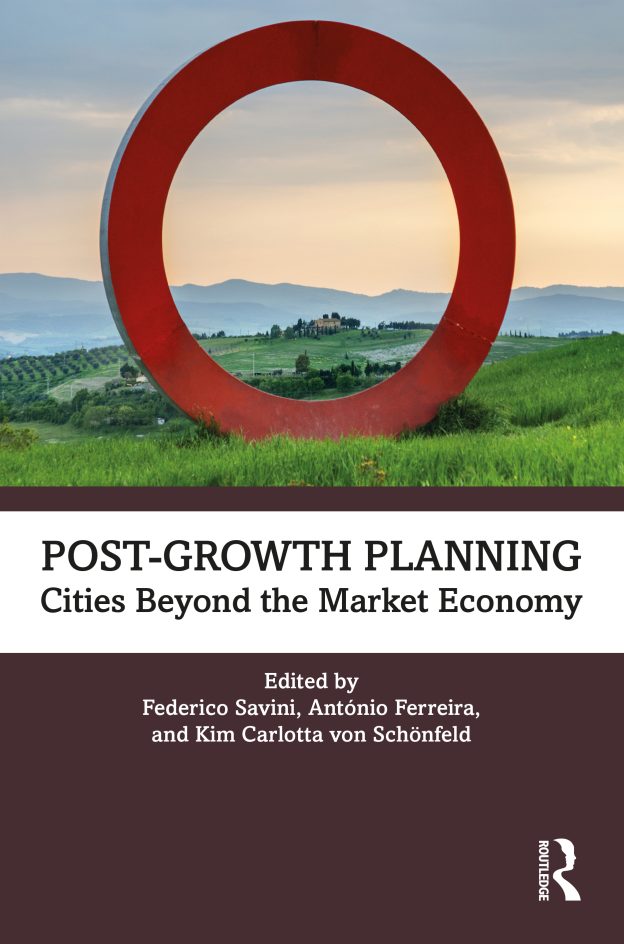The social and environmental impacts of capitalist growth-oriented development have been explored at length by scholars who have outlined the practices of actors like growth elites and the trajectories of neoliberal governance. Tim Jackson et al.’s work on the steady state economy, for example, has proposed environmentally driven, large-scale changes to the structures of entire economies. However, few attempts have been made to provide cases of place-specific strategies to generate planning alternatives to growth, with the exception of the literature on shrinking cities that largely finds new avenues for capitalist development under conditions of austerity in the guise of ‘planned shrinkage’.
As an alternative, the authors of Post-Growth Planning point to key social, cultural and political assumptions about development that underpin a propensity towards growth. In the words of the authors: ‘We need to question the taken for granted assumption that the given “reality” is the objective reality and that the alternatives are “unreal”, fanciful and no more than daydreaming’ (p. xvii). Federico Savini et al. point to the path-dependent logic of neoliberalism in which the market is treated as the most efficient way to distribute public goods; it is a logic that is keenly at odds with planning’s historical utopian hopes (e.g. The Garden City, The Radiant City, The Functional City).
Post-Growth Planning provides case studies and analysis of planning practices that rethink planning’s orientation to growth through contributions from those who are using empirical cases and data to imagine alternatives. Pushing beyond societal assumptions around the inevitability of growth-oriented development, this collection of writings by planning scholars provides new perspectives on the growth orientation of planning issues. The volume includes a variety of ‘post-growth’ alternatives, including organizing for collaborative housing models (e.g. commons, cooperatives, community land trusts), ways of reconsidering our mobility and transportation needs, and promoting cooperative and local food systems, and it questions the legal structures in place that promote growth as a development practice.
While the issue of a growth imperative for development has been extensively covered in the literature, this volume brings something new to the debate: an ambitious call to think bigger and an examination of the specific ways that post-growth has been experimented with—while also being honest about the gaps that remain. This type of transparency in how to grapple with the messy roots of structural inequality is lacking in planning praxis that often searches for prescriptive answers at the cost of thoughtful, critical analysis. In this book, the authors make an attempt at both suggesting solutions while critically engaging with their implications. In doing so, they challenge the tendency for planners to constantly be in search of a ‘best practice’ or policy tool that can be mobilized elsewhere.
As the book’s sub-title suggests, Post-Growth Planning: Cities Beyond the Market Economy fully resists this aspect of professional and academic planning culture and the temptation to tie the problem of post-growth planning into a neat package by engaging in the messy and necessary conversation around what these alternatives may (or may not) look like. In doing so, it examines and validates experiences such as community-led food initiatives and housing cooperatives, while taking care not to romanticize them as perfect solutions. The authors excel at providing glimpses of success, while at the same time pointing to the ways that these solutions are necessarily place-based and rooted in the specifics of local economies, cultures and social structures. In their words, the book aims to propose initiatives and practices that ‘should not be seen as blueprints for a no-growth, non-capitalist future (being), but as a prefiguration of alternatives in a non-linear process of transformation (becoming) which is riddled with tensions and contradictions and has uncertain outcomes’ (p. xix).
The invitation to this conversation that Savini et al. provide—as opposed to a collection of prescriptive case studies—is a real strength of the book and an approach that the planning profession would ideally adopt more widely as an alternative to its infatuation with normative, capital-driven practices. This is what Ferreira and von Schönfeld refer to here as ‘clumsy solutions’ (p. 88): ones that are not fully compatible with one particular theoretical framework alone, but are nonetheless helpful advancements in their flexibility and openness to change.
Overall, the ambitions of Post-Growth Planning to understand new practices that represent alternatives to growth are exciting. One aspect that is hard to ignore, however, is the tendency towards case studies in the global North and of economically privileged populations. This particular collection of novel experiences from relatively privileged actors—such as a chapter that centers the experiences of academics having limited mobility during the COVID-19 pandemic—leaves me wondering if the stories of groups and communities who have been forced to subsist outside of a growth mindset through necessity might offer more instructive cases. A deeper dive into communities with different degrees of access to formalized planning processes would likely be more revealing of new post-growth trajectories.
For example, how do communities experiencing racialized decline and planned disinvestment in so-called ‘shrinking cities’ innovate to provide resources and mutual support in such difficult circumstances? Or, how have those marginalized from the formal economy innovated and subsisted informally without a growth imperative? This collection seems to focus on the novel practices of those who are more or less included in formal economic development processes, but it’s possible that even more light could be shed on post-growth possibilities with lessons from those experiencing the much more ‘ordinary’ marginality that underpins capitalist social stratification.
Lisa Berglund, Dalhousie University, Canada
Federico Savini, António Ferreira and Kim von Schönfeld 2022: Post-Growth Planning: Cities Beyond the Market Economy. New York and London: Routledge. Cover used with permission of Routledge.
Views expressed in this section are independent and do not represent the opinion of the editors.

